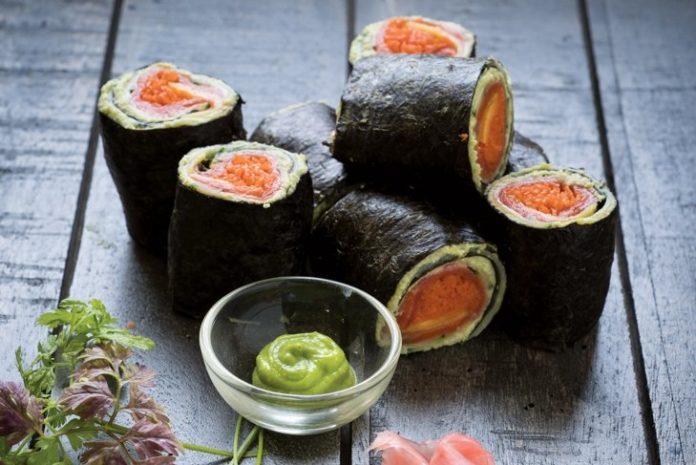
Fish aren’t the only nutritional powerhouses from the ocean. High in nutrients, low in calories, and awash in flavour, it’s time to make sea veggies your new go-to greens.
For millions of coastal people around the world, the briny vegetables known as seaweed are a significant part of their diet. But if the only seaweed you eat is the nori encircling your sushi, it’s time to get wet and wild more often.
Rather than the slimy stuff that squishes between your toes at low tide, think of seaweed as waterlogged kale—a nutrient-dense gift from the sea that’s ready to infuse mealtime with briny flavour worthy of a resounding “Ahoy, mateys!”
Sea vegetables such as wakame and dulse can definitely help you ride a health wave. As they ebb and flow with the currents, seaweeds soak up important nutrients, including iron, calcium, potassium, magnesium, and their signature mineral iodine, important for proper thyroid functioning.
They’re also likely a source of phytochemicals just begging for more research on their healing powers. Reel in dulse from East Coast waters and you’ll also soak up EPA (eicosapentaenoic acid), the same heart-healthy omega-3 fat found in salmon and mackerel. And being so exceptionally low in calories, you can eat nearly an ocean’s worth of the aquatic veggies without any waistline repercussions.
The culinary bonuses are notable, too. Since seaweed is swimming in glutamates—the building blocks of umami—it can add delicious taste to anything it touches. And, oh, those great textures! Start with these seaweed recipes that will make you see sea veggies in a different light.
Seaweed recipes
Smoked Salmon Nori Rolls

Dulse Egg Bowl with Tahini Sauce

Arame Pasta Minestrone

Seaweed Pesto Stuffed Tofu Steaks

Quinoa Seaweed Broccoli Slaw

More ways with seaweed
Sure, you could pull some green stuff out of the water during your next coastal vacation and open up, but here are some suggestions on getting your daily fill using more readily available packages of dried seaweed.
- Sprinkle dried seaweed flakes such as dulse on scrambled eggs, salads, mashed potatoes, warm grains, roasted root vegetables, stir-fries, pizza, and popcorn.
- Chop rehydrated seaweed such as hijiki or arame, and toss with other salad greens or use in slaws.
- Grind dry seaweed using a mortar and pestle or spice grinder, and then whisk with sesame oil, rice vinegar, minced garlic, lemon zest, and sea salt. Use as a salad dressing.
- Mix ground seaweed into meats when making burgers and meatloaf.
- Sneak chopped, rehydrated seaweed into pasta, tuna, or lentil salads.
- Slip pan-roasted dulse into sandwiches such as vegan versions of BLT.
- Cut nori sheets into squares and use it to scoop up ceviche in lieu of tortilla chips.
- Add chopped nori to trail mix.
- Use a strip of kombu (aka “nature’s MSG”) to flavour broths and bean-based stews.
- Add rehydrated seaweed to a bowlful of cooked soba noodles, tofu cubes, and sautéed vegetables.
- Blitz a few nori sheets in food processor and mix into cornbread batter.
- Stir dulse flakes and ginger powder into peanut butter and slather on toast or celery.
- Blend ground dried seaweed into dips for a “what’s that?” flavour twist.
- Add rehydrated seaweed to the filling mixture of spring rolls.
- Slice nori into small pieces and heat over medium heat in a skillet with sesame seeds until fragrant and seeds have browned. Stir in sesame oil and use as a garnish for grains, soups, and trendy poke.
Clean greens
Unlike the vast majority of other foods we eat, seaweed requires zero inputs of fresh water or fertilizer to grow, making it a sustainable addition to your diet. But sea vegetables, like fish, can soak up toxins such as heavy metals from surrounding waters.
Purchase wisely by seeking out bags of dried organic seaweed from natural food stores. To be certified organic, seaweed needs to meet specific guidelines, such as not being harvested near industrial-waste drainage sites. Or find a brand that plucks wild seaweed only from unfouled waters using sustainable harvesting methods that shun destructive large machinery.
You can also find out if a company runs laboratory tests for the presence of contaminants in their product. A North American-grown crop such as dulse from Eastern Canada may offer improved quality control compared to those from overseas.
Take a soak
Once harvested, seaweed is typically dried to dramatically prolong shelf life before being packaged.
To rehydrate for recipes, place parched seaweed in a bowl, cover with cold water, and soak for two to 10 minutes. (The longer it soaks, the more tender it will become.) Drain, squeeze out excess water, and chop down to desired size.
Remember that dried seaweed can swell to several times its size when soaked, so don’t give an entire bag a bath at once, unless you want your kitchen to turn into SeaWorld.









